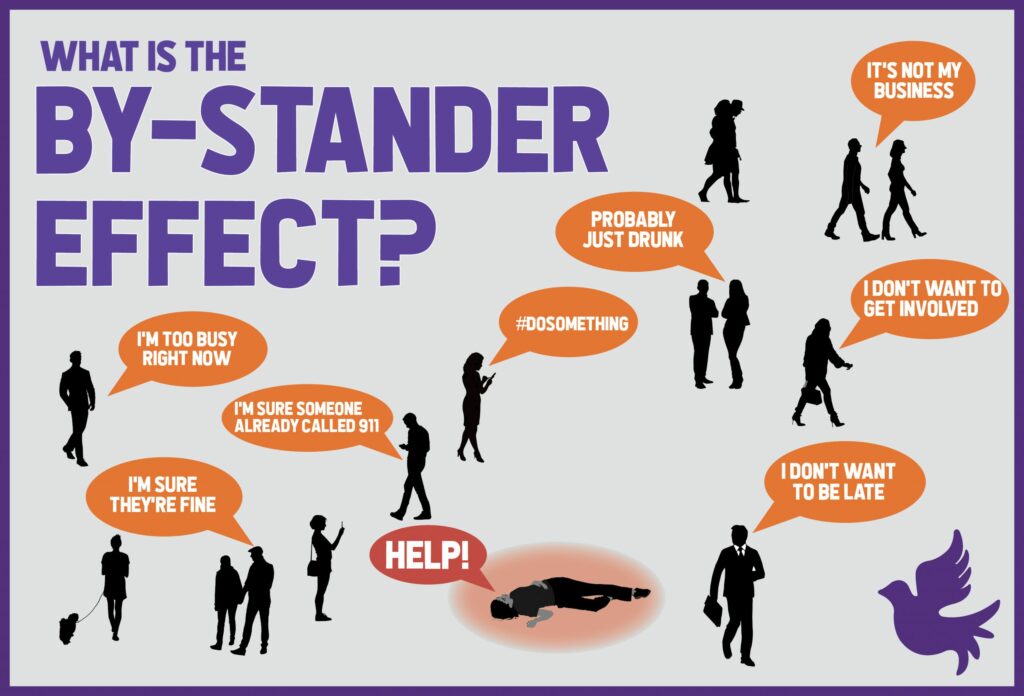What is the bystander effect? This is a social psychology phenomenon that occurs when people are in a group and don’t act because they assume someone else will. The term was coined in 1964 by John Darley and Bibb Latané after their study on the Kitty Genovese murder. In this study, it was found that 38 witnesses saw the attack and did not intervene. This tragic event brought to light just how much power the bystander effect has.
Contents
Understanding Bystander Effect
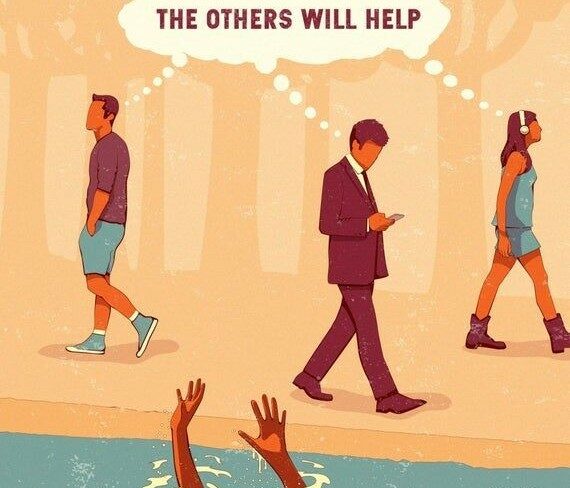
The bystander effect is a social psychology phenomenon that refers to the tendency of people to be less likely to intervene in an emergency when there are other people present. This term was coined by social psychologists Bibb Latané and John Darley in 1968 after they conducted a study on the topic.
Types of Bystander Effects
There are three primary types of bystander effects:
- the diffusion of responsibility, which is when people feel that someone else will take care of the situation so they don’t have to;
- the pluralistic ignorance, which is when people mistakenly believe that everyone else is just as unsure about what to do as they are and, as a result, don’t take any action; and
- bystander apathy is when people don’t take any action because they assume that someone else will.
Factors That Contribute To Bystander Effect
Several factors can contribute to the bystander effect. For instance:
- perceived costs of helping;
- familiarity with the situation;
- number of bystanders present;
- the certainty that someone else will help;
- the social relationship between the bystanders and the victim; and
- moral disengagement is when people convince themselves that they’re not responsible for helping because it’s not their problem or they’re not in a position to help.
Personality Types Prone To Bystander Effect
Several personality types are more likely to experience the bystander effect. For instance:
- who are apathetic;
- shy and withdrawn;
- don’t want to get involved;
- are afraid of making a mistake;
- are uncertain about what to do;
- who don’t want to make themselves look bad;
Citing Examples of Bystander Effect
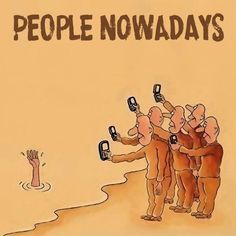
There are several well-known examples of the bystander effect in action. For instance:
- Challenger Explosion, in which many people saw the explosion but did not report it because they assumed that someone else had;
- Kitty Genovese case, in which 38 people witnessed a woman being raped and murdered for over 30 minutes but did nothing to intervene;
- Cleveland Steamer, in which a group of men witnessed another man being raped but did nothing to help because they didn’t want to get involved.
At Campus
There are several situations in which the bystander effect can occur on college campuses. For instance:
- sexual assault, in which many people feel like they don’t know what to do or how to help;
- alcohol poisoning, in which people may be hesitant to get involved for fear of getting themselves into trouble; and
- fire drills, in which people often ignore the instructions because they assume someone else is taking care of it.
At Workplace
There are several situations in which the bystander effect can occur at work. For instance:
- sexual harassment, in which people may feel like they don’t know who to report it to or how to help;
- bullying, in which people often don’t step in because they’re afraid of becoming the next target; and
- workplace accidents, in which people may not know what to do or how to help.
In Relationships
There are several situations in which the bystander effect can occur in relationships. For instance:
- domestic violence, in which people may feel like they don’t know what to do or how to help;
- sexual assault, in which people may feel like they don’t know what to do or how to help; and
- infidelity, in which people may not know how to react or what to do.
In Social Settings
There are several situations in which the bystander effect can occur in social settings. For instance:
- public speaking, in which people often feel like they’re the only ones who don’t know what to do;
- road rage, in which people often don’t intervene because they don’t want to get involved; and
- online bullying, in which people often don’t step in because they’re afraid of becoming the next target.
Evaluating Bystander Effect
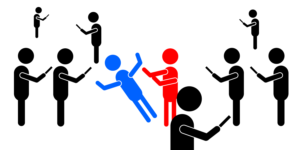
Several factors should be considered when evaluating the bystander effect. For instance:
- costs of helping;
- moral disengagement;
- the severity of the situation;
- the certainty that someone else will help;
- the proximity of the bystanders to the victim;
- relationship between the bystanders and the victim;
Why People Fail To Help In An Emergency
There are several reasons why people may fail to help in an emergency. For instance:
- don’t want to get involved;
- assume someone else will help;
- been conditioned to not get involved;
- don’t know what to do or how to help;
- afraid of getting themselves into trouble;
Can the Bystander Effect Ever Be Positive
There are a few cases in which the bystander effect can be positive. For instance:
- if the bystanders are working together as a team to help.
- if someone has previous training in how to handle emergencies; or
- if someone is feeling overwhelmed and needs time to process the situation before deciding whether or not to help;
Is It Wrong Not To Help In An Emergency
There is no right or wrong answer when it comes to helping someone in need. It all depends on the individual and their personal beliefs. Some people may feel guilty if they don’t help, while others may not feel comfortable getting involved. It is important to do what you feel is best for you and your own comfort level.
There are, however, some things you can do to help overcome the bystander effect. If you see someone in need, start by asking yourself if you could help. If the answer is yes, then take action. Even if your help isn’t needed, it’s still important to get involved. You never know what kind of impact you could have on the situation.
If you’re feeling uncomfortable or unsure about what to do, don’t be afraid to ask for help. There are plenty of people who would be more than happy to lend a hand. You can also find resources online or through your local community center.
No matter what, it’s important to remember that you are not alone. There are always people who are willing and able to help. So don’t be afraid to act – you could make all the difference.
Legal Risk If You Try To Help Someone
There is also a legal risk if you try to help someone. You could be sued if you don’t do it perfectly and the person gets injured. There are also laws that protect people who try to help in an emergency, but it can still be risky. So, before you try to help someone, make sure you understand the risks involved.
For example, if they are being attacked by someone, the attacker could turn on you. Or, if the person is having a seizure, you could get injured if you try to help them. It’s important to weigh the risks before deciding whether or not to help.
Therefore, people sometimes don’t help in an emergency because they are afraid of getting involved. They may not know how to help or they may be worried about getting injured themselves. Or, they may not want to get involved in a dispute.
There are also people who don’t help because they don’t think it’s their responsibility. They may believe that someone else will help or that it’s not their job.
NOTE: There is a very small risk of legal repercussions if someone does try to help someone in an emergency. The most likely scenario in which this would happen is if the bystander was injured while helping.
Good Samaritan Law
However, there are laws that protect people who try to help in an emergency. The “Good Samaritan Law” is a law that protects people who offer assistance to someone in need. This law varies from state to state, but it generally gives people immunity from being sued if they offer assistance. So, if you are worried about the legal risks of helping someone, you should check to see if your state has a Good Samaritan Law. This law will protect you from being sued if something goes wrong.
Overcoming Bystander Effect
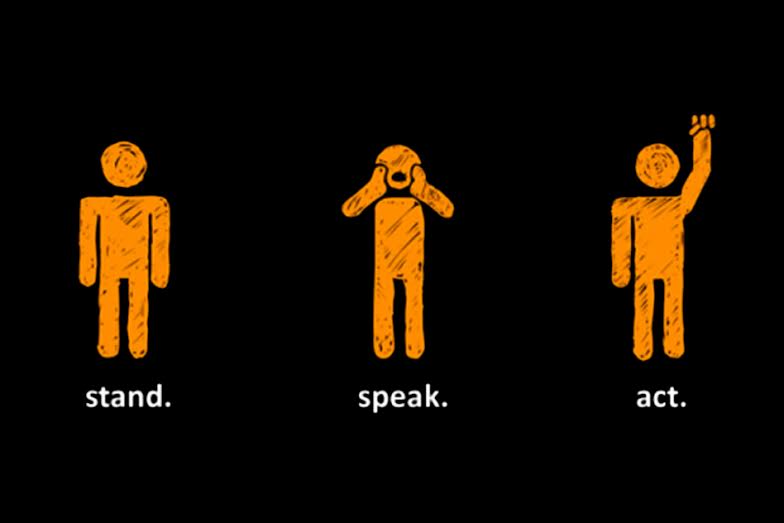
How To Be An Active Bystander
There are a few things that can be done to be an active bystander. For instance:
- offering help to the victim;
- creating a culture of accountability;
- joining a bystander intervention program;
- speaking up when you see something wrong happening;
- establish a personal code of conduct that includes helping people in need;
- regularly practice situational awareness, so you’re more likely to notice an emergency situation;
- be proactive in seeking out opportunities to help people, such as volunteering or joining a community organization;
Can You Avoid Being a Passive Bystander
There is no surefire way to avoid being a passive bystander. But there are a few things that can be done to make it more likely that you will intervene. For instance:
- working together as a team;
- feeling comfortable speaking up;
- knowing what to do in an emergency;
- previous training in how to handle emergencies;
- knowing that you won’t be punished for trying to help.
Hearing From Experts
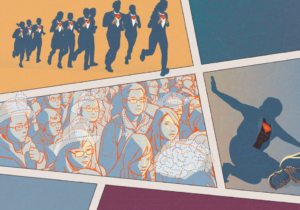
If you want to learn more about how to overcome the bystander effect, we suggest watching the following video:
In it, Lynn Fiellin and Robin Hattersley-Gray talk about the different ways that people can become more active bystanders. They also offer advice on how to get started if you’re not sure what to do. So, if you have any questions, feel free to leave them in the comments section below.
NOTE: Dr. Lynn Fiellin, an associate professor of medicine at Yale School of Medicine and the director of the Yale Center for Medicine and Law; and Robin Hattersley-Gray, the executive director of Green Dot.
Case Study
The Stanford Prison Experiment
In 1971, psychologist Philip Zimbardo experimented at Stanford University to study the effects of social roles on behavior. Thus, he recruited 24 male students. Then, he randomly assigned them to act as either prisoners or guards in a mock prison environment.
The results were shocking: the prisoners became docile and submissive, while the guards became authoritarian and abusive. As a result, the experiment was shut down after just six days due to the extreme behavior of the guards. This study is a prime example of the bystander effect in action: when people are given a social role, they often act by that role. Even if it means harming someone else.
Resources
If you have an interest in learning more about the bystander effect, the following resources may be helpful:
- The Stanford Encyclopedia of Philosophy has a detailed article on the bystander effect
- This TED talk by social psychologist Darley discusses the bystander effect
Conclusion
The bystander effect can have several negative consequences both at home and at work. So, it’s important to be aware of the factors that contribute to the bystander effect. And how to overcome it so that you can be more likely to help in an emergency.
A Word From Therapy Mantra
Your mental health — Your psychological, emotional, and social well-being — has an impact on every aspect of your life. Positive mental health essentially allows you to effectively deal with life’s everyday challenges.
At TherapyMantra, we have a team of therapists who provide affordable online therapy to assist you with issues such as depression, anxiety, stress, workplace Issues, addiction, relationship, OCD, LGBTQ, and PTSD. You can book a free therapy or download our free Android or iOS app.
